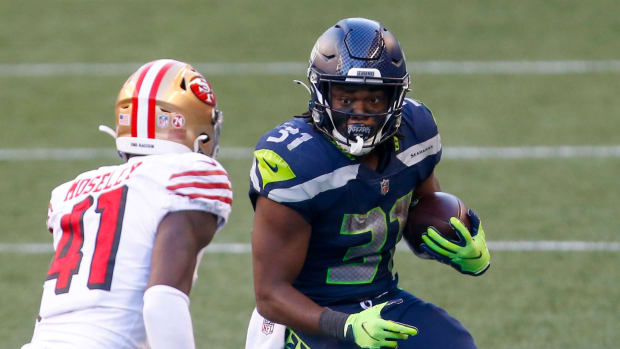If Chris Carson Leaves, Seahawks Shouldn’t Panic at Running Back
Becoming a more efficient running team appears to be at the top of Seahawks head coach Pete Carroll’s to-do list in 2021. Had the team sprinkled in the run game more consistently in its 30-20 wild-card defeat to the Rams, they may have been able to make a divisional round trip to New Orleans the following week—and Carroll likely realizes that.
In the Carroll era, pounding the ball has almost always been a staple for the Seahawks. Like it or not, the peak of their offensive success over the past decade has revolved around a thriving run game. It’s what has ultimately helped Russell Wilson establish a level of comfortability in games, allowing him to work off play-action and misdirection.
That’s when Seattle is truly at its very best. And despite what some may say, they never really got back to the ground even as the 2020 season dwindled. Including playoffs, the Seahawks called 206 non-quarterback runs to a whopping 404 passing dropbacks over their last 10 games. The only time they were ever “balanced” by pure definition was in their 40-3 dismantling of the Jets in which they had a straight 50-50 split (33 runs to 33 dropbacks), though that was more dictated by that particular game’s pace than anything.
Although Carroll expressed a desire to emphasize the run more as the season went along, the team clearly did not follow suit in its final games. It’s possible this is what led to the “philosophical differences” cited by Seattle in its firing of former offensive coordinator Brian Schottenheimer. Perhaps Schottenheimer was unwilling to take the ball out of his star quarterback’s hands more often, or it was a consequence of Chris Carson and Carlos Hyde’s injury struggles throughout the season. Probably a bit of both.
Under the supervision of Schottenheimer’s replacement, former Rams passing game coordinator Shane Waldron, the Seahawks are going to look to build a creative rushing attack to complement Wilson’s gifts in 2021. But how can they accomplish such a feat when they’re faced with the potential departures of their two top running backs last year?
If you’re a part of the “running backs don’t matter” camp, you’ve likely already shrugged this topic off. Heck, anyone who feels that way probably didn’t even click this article. However you may feel about running backs, it’s hard to deny the Seahawks’ run game is at more of a disadvantage than it was a month ago.
Specifically looking at Carson, Seattle is on the brink of losing one of the few true playmakers at the position in today’s game. When Marshawn Lynch retired for the first time, it was nearly impossible to imagine how the team could maintain its unmatched physical identity. But aside from a woeful 2017 season, the Seahawks have had the fortune of hardly skipping a beat in the backfield and Carson - who embodies the punishing nature of Lynch - has been a key part to that.
That said, should they do everything in their power to bring Carson back this offseason? Though it depends on what “everything in their power” entails, the answer is probably not. It’s hard to nail down how the free agent running back market will shake out this offseason, but the general consensus appears to be that the Seahawks will be well outbid for Carson’s services. They’re in a fairly tight spot from a salary cap standpoint, and while there are certainly avenues they can take to create more flexibility for themselves, breaking the bank for a running back would be ill-advised when they have even bigger needs at several other spots. Same goes for any replacement they could potentially look at in Carson’s absence.
Even without Carson or any other “splashy” move at running back, they can still reach the standard they’ve apparently set for themselves next season. But nothing they do at the position will ultimately get them where they want to go. If you don’t have one of the handful of backs who can transcend the pieces around them, you build a scheme and a group of blockers that can do the job for you.
Of course, you still need talent in the backfield. You can’t just throw anyone out there and hope for the best. And it’s not like the Seahawks’ current stable of backs is inept by any means.
Former first-round selection Rashaad Penny is in line to see the bulk of the workload in his first full season back from an ACL tear; DeeJay Dallas showed promise in his rookie year and earned the respect of Wilson and his coaching staff; and Travis Homer is still a solid pass protector with some physical ability on the ground.
The Seahawks would probably be best served investing in a pair of interior offensive line and reuniting with someone like Mike Davis to split carries with Penny. Depending on where their needs sit once the draft comes around at the end of April, they could also use one of their few selections on a back as well. But that shouldn’t come until the later rounds.
Anything else would be a severe misstep. The Seahawks cannot panic when addressing their running back position if Carson leaves, no matter how desperate they are for a more balanced approach in 2021. That’s what they did when they drafted Penny in 2018 following a dreadful, injury-plagued season, much to the dismay of their fan base. In the end, they wound up primarily using their seventh-round selection from the year prior, Carson, instead.
Even if they can’t recreate the magic they found with Carson out of seemingly nowhere, there are other ways to build a functional and sustainable ground game. The Seahawks have been spoiled by having otherworldly talents in the backfield over the past decade and they must come to the realization that the key to success in 2021 may not be the ball-carrier, but the operation as a whole.




